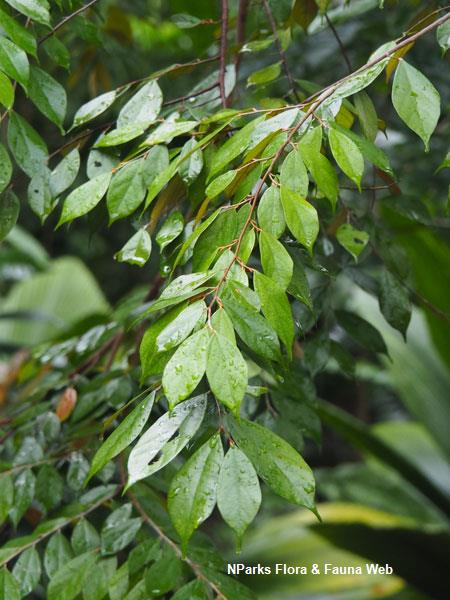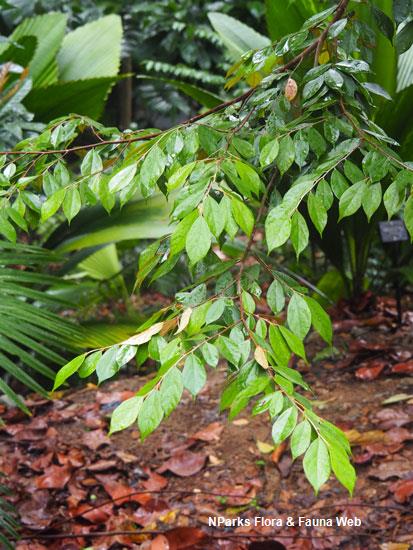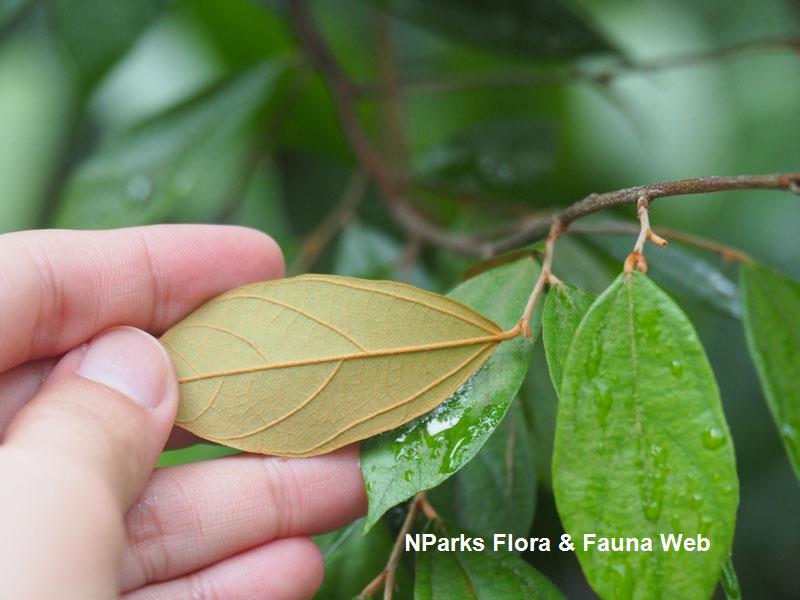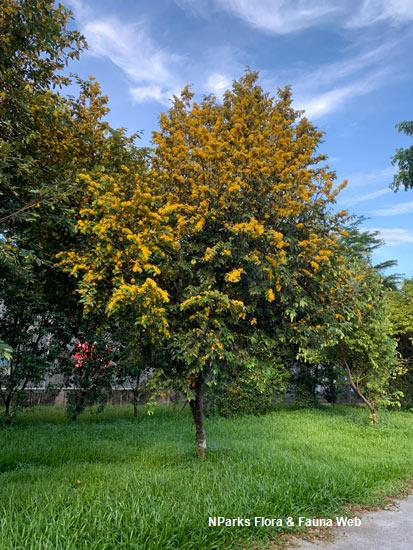
Back
Schoutenia accrescens (Mast.) Merr.
| Family Name: | Malvaceae |
| Common Name: | Bayur, Bayur Bukit |
Schoutenia accrescens, also known as Bayur, is a tree that can grow up to 35 m tall. Its young branchlets, leaf undersides, stipules and petioles are covered with brown stellate hairs. The timber is valued for a wide range of uses, including house construction and cabinetry, while the bark is used to make ropes.
Name
Classifications and Characteristics
| Plant Division | Angiosperms (Flowering Seed Plants) |
|---|---|
| Plant Growth Form | Tree |
| Lifespan (in Singapore) | Perennial |
| Mode of Nutrition | Autotrophic |
| Maximum Height | 35 m |
Biogeography
| Native Distribution | Thailand, Peninsular Malaysia and Borneo |
|---|---|
| Native Habitat | Terrestrial |
| Preferred Climate Zone | Tropical |
| Local Conservation Status | Non-native |
Description and Ethnobotany
| Growth Form | It is a deciduous tree that can reach up to 35 m tall with dark brown bark. |
|---|---|
| Foliage | The leaves are elliptic to ovate-lanceolate or slightly obovate, measuring 0.5 – 13 cm long and 0.5 – 5.5 cm wide. Each leaf has 4 – 5 pairs of lateral veins, which are prominent on the underside. The leaf tip is pointed (acuminate or bluntly cuspidate) while the base is unequal (oblique) to rounded or wedged shaped (cuneate). The upper surface is glossy green whereas the underside, especially in young leaves, is covered with brown stellate hairs. Young branchlets, stipules and petioles are similarly covered with brown stellate hairs. The stipules fall off early and the petiole measures 2.5 – 7.5 mm long. |
| Flowers | The flowers occur in a branched cluster at both terminal and axillary positions. The calyx is bell-shaped, large (about 1 – 3 cm long), yellow or pink in colour, with triangular lobes. Each flower contains 30 – 40 stamens and the ovary is obscurely 5-lobed. |
| Fruit | The fruit is globose, about 0.7 cm in diameter, with persistent shallowly lobed calyx. |
| Habitat | It is found in rainforest, up to 750 m altitude. |
| Associated Fauna | Flowers are pollinated by insects. |
| Etymology | The genus epithet is named after Willem Cornelisz Schouten (1567 – 1625), a Dutch navigator who discovered the Schouten Islands in 1616. The specific epithet accrescens, in Latin, means growing together, referring to the persistent calyx on the fruit. |
| Ethnobotanical Uses | Timber & Products: The timber is used for building houses, cabinets, tool handles, spokes, wheels and as pegs for boat construction. The bark is used to make ropes. |
Landscaping Features
| Desirable Plant Features | Ornamental Flowers |
|---|---|
| Landscape Uses | Parks & Gardens |
Fauna, Pollination and Dispersal
| Pollination Method(s) | Biotic (Fauna) |
|---|
Plant Care and Propagation
| Light Preference | Full Sun |
|---|---|
| Water Preference | Moderate Water |
| Plant Growth Rate | Moderate |
Foliar
| Foliage Retention | Deciduous |
|---|---|
| Mature Foliage Colour(s) | Green |
| Foliar Type | Simple / Unifoliate |
| Foliar Apex - Tip | Acuminate, Cuspidate |
| Foliar Base | Oblique / Asymmetrical, Rounded / Obtuse, Cuneate |
Non - Foliar and Storage
| Trunk Type (Non Palm) | Woody |
|---|---|
| Root Type | Underground |
Floral (Angiosperm)
| Flower Colour(s) | Pink, Yellow / Golden |
|---|---|
| Flower Grouping | Cluster / Inflorescence |
| Flower Location | Axillary, Terminal |
| Individual Flower Shape | Campaulate / Bell-shaped |
References
| References | Corner, E.J.H. (1940) Wayside Trees of Malaya. 2 vols. Singapore: Government Printing Office Kochumen, K.M. (1973). Tiliaceae. In: Whitmore, T.C. (ed.), Tree Flora of Malaya 2: 392–412. Hong Kong: Wing Tai Cheung Printing Co. Ltd. Phengklai, C. (1993). Tiliaceae. In: Smitinand, T. & Larsen, K. (eds), Flora of Thailand, vol 6, part 1, pp. 10–80. Bangkok: The Rumthai Press Co. Ltd. Roekmowati-Hartono (1965). A monograph of the genus Schoutenia Korth. (Tiliaceae). Reinwardtia 7 (2):91-138. Sosef, M.SM., Hong, L.T., and Prawirohatmodjo, S. (Editors). 1998. Plant Resources of South-East Asia Volume 5 (3). Timber Trees: Lesser known timbers. Leiden: Prosea Foundation. 859 pages. |
|---|
Image Repository
Others
| Master ID | 1977 |
|---|---|
| Species ID | 3269 |
| Flora Disclaimer | The information in this website has been compiled from reliable sources, such as reference works on medicinal plants. It is not a substitute for medical advice or treatment and NParks does not purport to provide any medical advice. Readers should always consult his/her physician before using or consuming a plant for medicinal purposes. |




